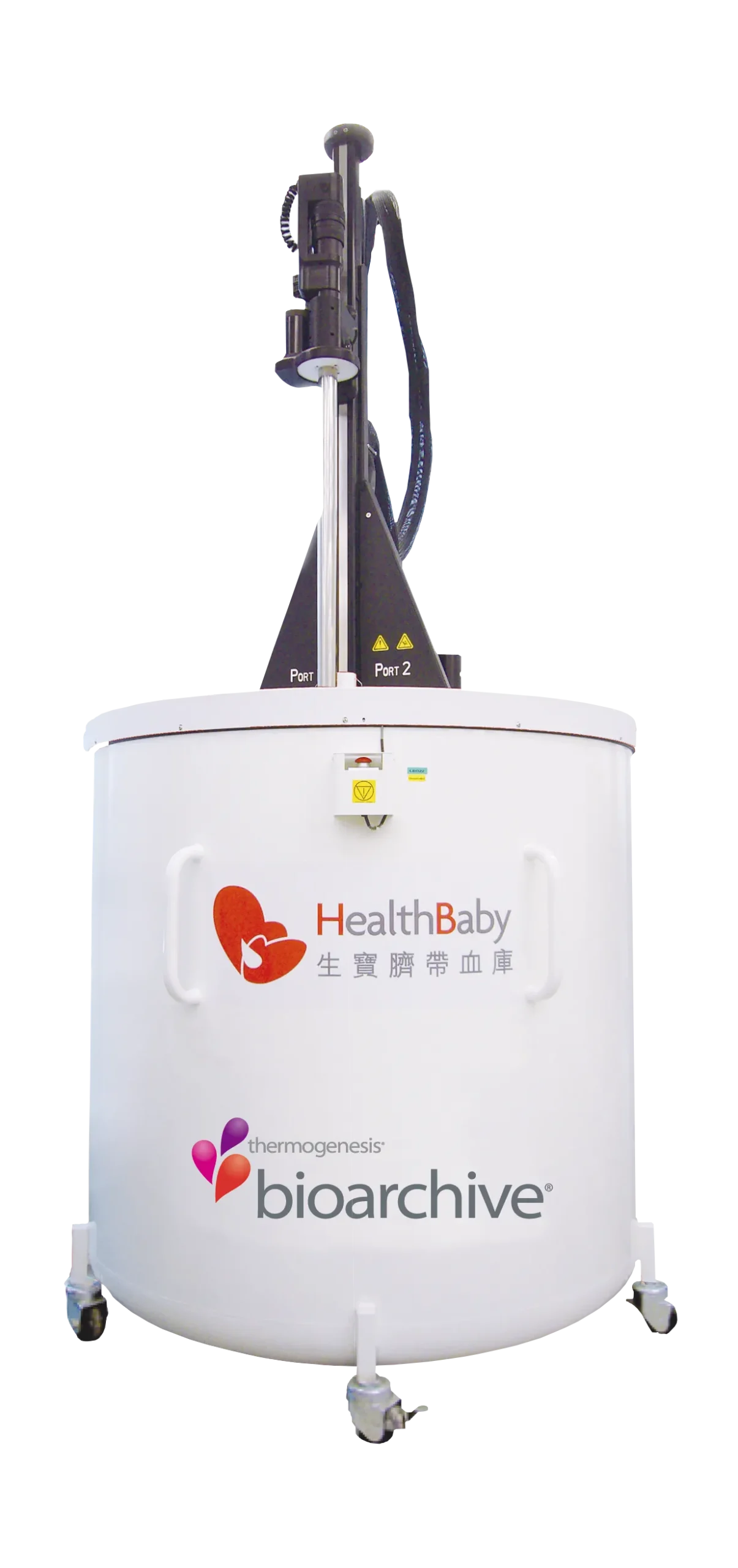
Specifically designed for stem cells processing and storage
Globally Well Recognized System
Increase Survival Rate after Transplant
Closed system handling to maintain stable temperature
Survival rate will be 10% higher after transplant15

- FDA cleared, specifically designed for stem cells storage
- Adopted by 170 cord blood banks in 42 countries
- Adopted by worldwide large blood banks and 90% cord blood banks in Europe, as well as New York Blood Centre which performed most transplants worldwide
- Provided over 75% stem cell samples of global cord blood transplants17
- Survival rate is 10% higher than traditional tanks after transplant15
- obotic storage and retrieval system
- Closed system handling, eliminating the TWEs occurred in traditional tanks, which affect stem cells viability for future transplant18
- Use of liquid nitrogen (stable temperature at -196˚C) as storage media, which is recommended by reports for long-term stem cells storage19
- Built-in computerized monitoring system with precise storage record. No external equipment needed
- Liquid nitrogen reservoir can maintain stable temperature for more than 50 days without electricity supply
- No quality issue and recall history with BioArchive® in HealthBaby
- FDA Cleared, never been compulsory recalled 20,21. Worldwide large blood banks implemented the BioArchive system to enhance the efficiency and quality of cord blood storage. In addition, 90% of the cord blood bank in Europe adopted BioArchive® system. It proves that this system is globally well recognized.
Cell Viability is the Key of Successful Rate of Transplants
Storing cord blood and umbilical cord is a lifetime safeguard for your children and families. No one wants to have chances to use one day, but if it really happens, have you ever thought of low viability of stem cells will let cord blood and umbilical cord lose its functions? HealthBaby introduced BioArchive® liquid nitrogen storage system which is adopted by most of public cord blood bank in globe (including New York Cord Blood Center, Tokyo Cord Blood Bank and worldwide large blood banks), the purpose is to give the best safeguard for parents.
Use of liquid nitrogen (stable temperature at -196°C) as storage media is recommended by reports for long-term stem cells storage19. Only liquid nitrogen can keep stable -196°C amd cord blood stem cells will suspend all physiological activities and remain dormant. On the contrary, other cord blood banks claimed that stem cells can be stored at 135 ℃ for permanent storage while there is no scientific evidence to prove so. And using traditional vapor nitrogen tank will lead to temperature fuctuation resulting from transient exposure to surrounding air while the stem cells are being cryopreserved, taken out, transported and transferred to vapor nitrogen tanks for storage. Vapor Nitrogen combined with TWEs will lead to loss of viability.
Specificity
- FDA cleared, specifically designed for stem cells storage
- No compulsory recall by FDA due to stem cells quality20,21
- For biological samples storage previously
Controlled Rate Freezing
- Built-in controlled rate freezer and eradicates TWEs
- Steady freezing rate at 2.8℃/min for optimal stem cells condition
- External freezing procedure is required and samples have to experience unnecessary times to temperature differences and prolonged entry period
Transplant Quality
- Provided over 75% samples of successful transplants worldwide
- Survival rate is 10% higher than traditional tanks after transplant15
- No significant increase in survival rate
Storage Media
- Liquid nitrogen (-196˚C)
- Stable temperature to maintain optimum stem cells viability22,23
- Constant temperature, permanent storage for over 1,000 years19
- Liquid nitrogen reservoir can maintain stable temperature for more than 50 days without electricity supply
- No quality issue and recall history with BioArchive in HealthBaby
- Liquid (Adopted by HealthBaby) / vapor nitrogen
- The temperate of vapor nitrogen is unstable and may affect the viability of stem cells
Global Usage
- Adopted by over 80% Netcord’s cord blood banks
- Adopted by most public cord blood banks worldwide(including New York Cord Blood Center, Tokyo Cord Blood Bank and worldwide large blood banks). Since the cord blood samples are for local public use, the quality requirement is much higher than that of private blood bank, to ensure all samples reaching transplant standard
- Adopted by 60% cord blood banks in developed countries
- Mainly adopted by private cord blood banks
Cross Con-tamination
- No matter the cord blood stores in liquid nitrogen or vapor nitrogen, a cross-contamination might happen if containers are not airtight. Only sealed containers can eliminate eventual cross-contaminations24,25
- Reports showed sealed TG compartment molded freezing bags with liquid nitrogen storage can eradicate cross contamination34
- Cross contamination cases happpened25
Design and Operation
- Closed design with stable storage temperature
- Independent access of samples by periscope without affecting others
Eradicated TWEs, high stem cells viability guaranteed - Built-in 24-hour surveillance system for instant alarm
- Manual mode to access samples for contingency
- Open system causing inconsistent temperature inside the tank25
- Shared compartment, accessing of one sample will also cause others exposed in great temperature difference18
- Transient Warming Events (TWEs) may affect stem cells viability
- Manual operation increases the risk of human errors
Transient Warming Events (TWEs)
Reduce Stem Cells Viability and Affect Transplant Quality
TWEs refers to temperature fluctuation resulting from transient exposure to surrounding air while the stem cells are being cryopreserved, taken out, transported and transferred to vapor nitrogen tanks for storage since they must operate in coordination with an external and independent freezing device. Such kind of repetitive temperature fluctuation will finally cause stem cells bursted and even died. Research report states that TWEs will reduce the number of stem cells even though it does not reach the significant level (>5%) in statistics. The fact is that millions of stem cells are lost due to TWEs18. Another report shows that Vapor Nitrogen combined with TWEs can lead to 20% loss of viability26.
More Questions?
Contact us through any method below:
Hotline: (+852)3188-8899 / (+853)2878-6717
WhatsApp: (+852)9660-8271 or Click Here
WeChat: HealthBaby 生寶臍帶血庫
Online: Click here to submit the enquiry online
Email: enquiry@healthbaby.hk



